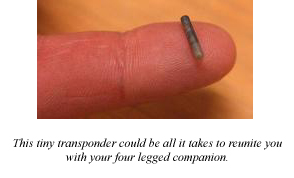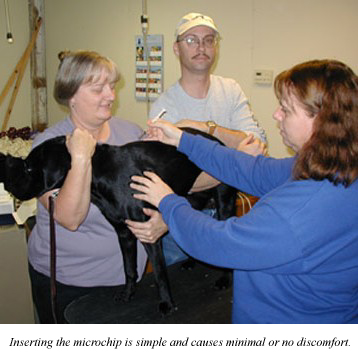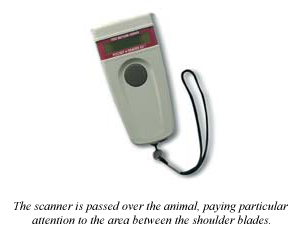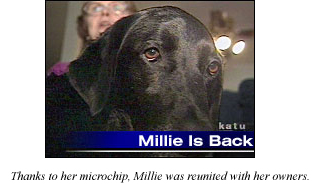


Christmas Store
The holidays are just around the corner so now is the time to fetch the finest gifts for the Labrador Lover on your Christmas list. We have over 100 gifts $50.00 and under. Visit our Christmas Store.
For the Lab
Bedding
Coats
Collars and Leads
Dog Bowls
Feeding Stations
Spa and Grooming
Toys and Treats
Travel and Accessories
For the Lab Lover
Apparel
Cards and Giftwrap
Fine Accessories
Gifts and All Occasions
Jewelry
Kids Only
For the Lab Home
Artwork
Books
Garden and Outdoor
Home Furnishings
Kitchen Accessories
Pillows, Throws, and Rugs
Gift ServicesGift Boxes
Gift Certificates
A Microchip Can be Your Dog's Ticket Home

There were thousands of displaced pets that were victims of hurricanes Sandy and Katrina. With hurricane Katrina as fast as shelters in Louisiana, Mississippi, Alabama and Florida were being emptied by rescue groups, they were being filled again by the tens of thousands of pets still stranded by the hurricanes. Some officials estimated that there were as many as 11,000 pets displaced from New Orleans by hurricane Katrina alone.

But it doesn’t have to be a disaster which causes the separation from your loved one. Imagine if one morning you open your front door to retrieve the newspaper and Shadow dashes through the door in pursuit of a squirrel, a cyclist or even the neighbor’s cat. Or perhaps a thunderstorm causes him to jump the fence and bolt off. Losing a pet can be heartbreaking, and an unsuccessful search even more so.
Even if Shadow has a license and tags, he may not always be wearing his collar, and collars and tags come off or unfortunately may even be taken off by thieves. For many years, because collar tags were so easily lost or removed, pet owners and breeders have relied on tattoos as a more permanent form of pet identification. A tattoo is etched on the inside of the dog’s thigh near his abdomen. The area is shaved to make application easier and less irritating to the skin, but as the fur grows back it can obscure the tattoo number.
Tattoos have drawbacks; although they cannot get lost as tags can, they can be hard to find and read if the dog is scared, aggressive or has a heavy coat. Many shelters do not search for tattoos; dogs that enter shelters are often traumatized by the experience and can be too difficult to handle so that the tattoo can’t be found.

Enter the microchip, one of the latest and most popular forms of identification. A microchip is a capsule-shaped tiny transponder the size of a grain of rice, measuring 2.0mm in diameter and 11.0mm in length. The chip, antenna, and capacitor are encased in a tiny glass tube. The tube is composed of soda lime glass which is known for compatibility with living tissue and should have no physical effect on the animal. The device itself contains no batteries or chemicals and its electronic circuitry is only activated when it is being scanned. It has an active life of about 25 years, well past the life of your dog.

The method of implanting the microchip is very much like administering a vaccination. The microchip comes pre-loaded in a sterile syringe-like instrument. The microchip is implanted subcutaneously (between the skin and muscle tissue) on the back of the animal’s neck, between the shoulder blades. Microchips can be implanted without anesthesia, as the pain involved is minimal, about the same as an ordinary injection. The entire procedure takes less than 10 seconds. Post-injection reactions are very rare and once inserted it can only be removed surgically. Being under the skin, it is safe from weather, erosion, alternation, theft and cannot be seen by the human eye.
Before and after implantation, the chip is scanned to make sure it is working and in the right place. The owner is given a registration card to be mailed to the registration service, which is the “clearinghouse” when a dog is lost, thus allowing the owner to be contacted.
The age at which this can be done varies with the size and development of the dog, as a certain amount of muscle tissue is necessary. With larger breeds, it can be done by 7 weeks, which is the time when most puppies go to their new homes. Most vets generally now have the capacity to insert the microchips. Implanting the microchip and registering the information costs around $25.00, so it is a wonderfully low cost approach to identification.
Each microchip has its own universally recognized identification number, which means that even if millions of microchips are implanted worldwide, each one can be identified without fail. Microchips are a form of automatic identification technology, similar to bar codes and magnetic stripes. Because they use radio-frequency signals to relay the stored information, they are referred to as radio-frequency identification (RFID).

Once the microchip is successfully implanted, it can be read using a scanning device called a microchip reader. The scanner emits a low-frequency radio signal (125 kHz), activating the microchip. The frequency is picked up by a tiny antenna in the transponder and the number is retrieved, decoded, and the ten digit number is displayed in the microchip reader’s LCD screen. Scanners are provided to animal control, humane shelters and other rescue organizations so that all stray pets are scanned and those with microchips are reunited with their owners.
By consulting the appropriate chip registry database, relevant information —including the dog’s owner, breeder, emergency contact, even health problems and food requirements can be obtained. That’s why it is important to report your address or phone changes to the clearinghouse so its data is always current and accurate. There are no annual fees, owners pay a one time fee for registration, but there is a charge for information changes such as change of address. Change of ownership will require a new registration.
There are two primary microchip manufacturers in the United States. They market their products under the names “Home Again” and “AVID” (American Veterinary Identity Devices). Programs like the American Kennel Club (AKC) Companion Animal Recovery (CAR) program maintain worldwide databases so they can help reunite lost pets with their families. According to the AKC CAR, more than 900,000 pets and companion animals have been registered in its database, which also includes tattooed animals, and almost 50,000 pets have been reunited with their families.
The advantages to microchips are obvious — the process is quick, inexpensive, no more painful than a vaccination, the chip can’t get lost like a collar can, the number is unique, the dog can be easily scanned and the owners name and address is available on a regional and/or national database so a dog can be returned quickly and safely. It is advisable to have your veterinarian test the microchip on an annual basis in order to make sure that it is properly transmitting data.
There are some drawbacks though. A few chips do move out of place, a problem that Schering Plough’s marketer of the Home Again microchip has addressed with a polypropylene shell on the tip of the transponder. This coating bonds the transponder to the dog’s subcutaneous tissue. And although more and more pet owners are microchipping their pets, there are still a number of shelters that do not have scanners, and many pets are picked up by good Samaritans rather than somebody with scanner access. Still it does increase the likelihood that if your dog dashes out the door that you and your loved one will be united.

Just ask Frances Jackson owner of Millie a Labrador Retriever who went missing for five years and was returned to her owners because she had a chip implant. Where Millie spent the five years is a mystery, but when Millie showed up at an animal shelter, workers were able to track down her home because she wears an id number microchip.
 Can You Spot The Holiday Hazards?
Can You Spot The Holiday Hazards?It’s easy for pets, especially Labradors, to get into trouble during the holidays. You may get so busy that you lose track of what is going on with your dog.
Click here to learn more about: "Can You Spot The Holiday Hazards?"

Would you like to see your Lab pictured here? Send us images of your Lab and we may include them on our Home Page!
Labrador Links
The Verstaile Lab
History of the Lab
Advice
Travel
Featured Labs
Featured Artists
.jpg)

